

 当前位置:首页 -- 学术论坛
当前位置:首页 -- 学术论坛 中国书画的陈列与保护
海蔚蓝
Installation and Protection of Chinese Calligraphy and Painting
Hai Weilan
中国书画在千年的历史中,作为中华民族的一种独特的艺术形式,不仅形成了自己别具一格的方法、内涵、美学取向、而且也具有特别的装帧形式。一般来说,是众所周知的三种主要形式,即立轴、手卷、册页。
Chinese calligraphy and painting is a unique art form of the Chinese nation in the history of the millennium. Not only formed its own unique method, connotation, aesthetic orientation, but also has a special form of mounting. Generally speaking, it is a well-known three main forms, namely hanging scroll, hand scroll, and album.
古人欣赏书画,若是挂在客厅的立轴、中堂,大约敲颗钉在墙上,用画叉竿子一支就挂上去了,便可让家人亲友观看;手卷和册页大约多为私下观赏的,或是三五知己,或是讌会雅集,文人学士展卷把玩,兴诗题跋。这种观画方式可从现存的绘画题跋中,或如“西园雅集”之类的绘画作品中看到。聚会完了,就放回樟木盒子,或裹进蓝布锦绢之囊存放。因此,当博物馆将这些本是多为私人观赏的艺术品,面对公众时,便面临一个如何展示的问题。于是,八仙过海,各显神通。在此,我仅以在纽约华美协进社中国美术馆近三十年的实践为例,略述对中国书画的陈列与保护的体会。
The ancients appreciate the calligraphy and painting, they may be hung the hanging scrolls in the living room, just hold up with a forked stick and hung it on a knocked in nail on the wall, to allow family members and relatives to watch. Hand scrolls and albums are mostly privately viewed. They would be usually appreciated among friends, in the gatherings of the students and the scholars, while the viewers might also create poems and wrote colophons. This traditional way of appreciating Chinese calligraphy and painting, can be seen in the existing painting colophons, or in paintings such like the “West Garden Gathering”. When the party is over, the hand scrolls and albums would be put back in the camphor boxes, or wrapped in cloth or colored brocade silk bags. Therefore, when the museum takes these artworks, which were mostly private, to the public, they face a problem of how to present them. As it is said, just like The Eight Immortals crossing the sea and each showed a supernatural power. Each museum would create their own ways to present the artworks. In this case, I would like to share the experiences accumulated from the last 30 years of practice at the China Institute Gallery in New York as an example to briefly describe how to install and protect the Chinese calligraphy and painting through the exhibitions.
中国书画在展陈中有两点最重要:一是展陈的效果,一是书画的保护。常言道:人靠衣裳马靠鞍,三分画画七分框。任何艺术品的展示,都得靠辅助的展示手段。若论展陈书画的效果,首先应该考虑的是,如何保存其书画原本的形式,并展现其最精彩的部分。既然书画是主角,作为辅助陈展的材料,理所当然不能喧宾夺主。因此书画的展陈,在安全保护的前提下,应以最大限度地少用辅助材料为准则。
There are two most important points in this procedure: one is to achieve the effect of the appearance of the artwork; the other is the protection of the artwork. As the saying goes, people rely on clothes, horses rely on saddles, and paintings rely on the wonderful frames. The installation of any artwork has to rely on auxiliary means of display. The first thing to consider is how to preserve the original look of the calligraphy and painting, and to show the most exciting part. Since the calligraphy and painting is the main character, the display materials or methods just serve as an assistance, of course, cannot take over the master. Therefore, the installation of calligraphy and painting, under the premise of safety protection, should be based on minimizing the use of supporting materials.
首先,所有书画如果不是在本馆内运作,而是由外馆运到展示场地的,需要停留48小时后方可打开,让其适应新环境的温湿度,以免纸、绢、装帧材料,在突如其来的环境的急剧变化中遭受暗伤或受损。
First of all, if all the calligraphy and painting works are not stored in the presenting museum, but are transported from outer venues, it needs to stay for at least 48 hours before it is opened, to allow them adapting to the temperature and humidity of the new environment. In order to avoid any hidden damages that may happen to the paper, silk, and framing materials in the sudden changes of the environment.
立轴的陈列与保护:一般来说,在立轴的天干中央,已有一根用于悬挂的线带,应该说立轴或许是最易陈列的。但在博物馆的做法,确不能像在家里墙上敲颗钉,就挂上去那么简单。首先得确定其高度,这一悬挂的高度,是以整个展厅的中心高度为基数的,即观众视觉上最舒服的高度。按照美国博物馆的经验,一般是在58至60 英寸之间。如果是常规高度的立轴,若用其已有的悬挂线,其中心高度恰在这一范围左右的,那就很简单,按照画面中心,找到悬挂高度,定点钻孔,钉钉,挂上就行。如果是一幅过于高大的立轴,可能就需要调整画轴的两端,来达到这一个统一的中心高度。立轴上端需要卷起时,有些博物馆是使用一种有机塑料筒,一侧开口将天干和悬挂的线与别子插入其中,然后依着塑料筒,将画幅上方多余的部分卷起来后固定悬挂。那样应当是安全的,但直观上,塑料筒太突出,有碍立轴本身的形式美。因此,多年来我主张凡是贴近展品的陈列材料,应尽量少用或不用有机玻璃,觉得有机玻璃这一材料,在观感和感觉上有违古代书画的材质和气质,并在观赏效果上造成隔阂,而坚持用自然本真的材料来展陈。
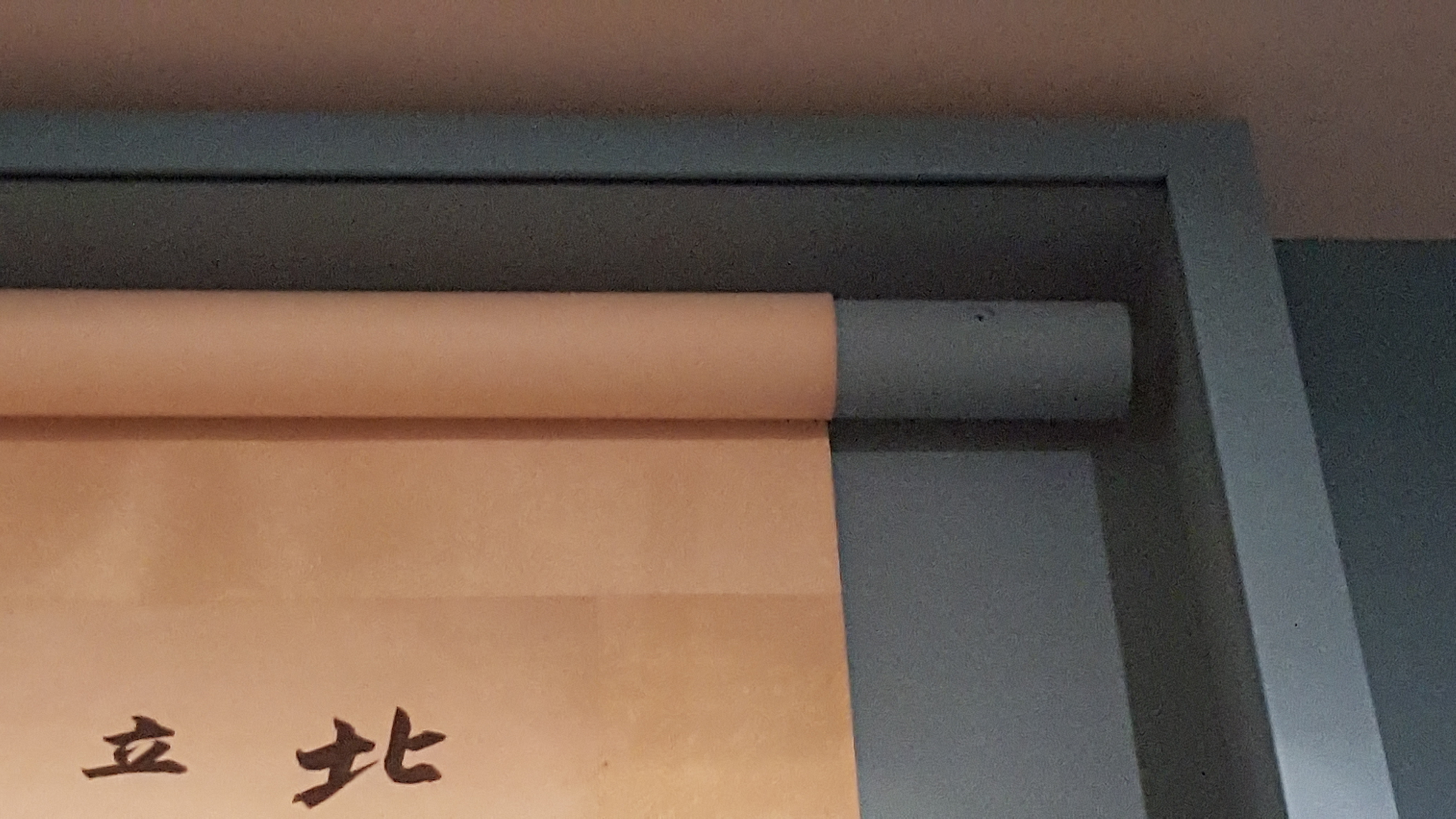
插图1。过高立轴的上部陈列法 fig.1. Detail of displaying the top of a hanging scroll
多年前,我的展览设计师因此发明了用原木棍(插图1。过高立轴的上部陈列法),约两至三英寸的直径(按需要而定),抛光后,切割成比立轴天干略宽的尺寸,依照天干的宽度,找到中心和需涂抹颜色的点,即天干是十六英寸的话,这根木棍就大约是22英寸,两边各留3 英寸的地方是涂成该展选用颜色的部分,在这两边三英寸的中心部位各钻一孔待用。将一层防酸绵纸把原木棍未涂颜料的16英寸的部分包裹起来,这一片纸可略为小于16英寸,这样就不会露出纸边,然后将它挨着天干,小心的一起卷起来,卷到合适的高度,然后,将原木棍的两端,用螺丝钉在预留的孔中固定,两边都固定后,立轴就稳定了,显露的是书画装裱的本身,原木棍两端与展柜的颜色相似,因此观众的眼睛看到的是画本身,而看不出多少人为的努力。立轴画的下端如果太长的话,就可直接卷起,卷到需要的地方,将两端的轴头以粗铁丝弯成的圈固定。铁丝圈的一端钉入柜墙,另一端圆圈状的外罩透明软塑料管,勾住和固定轴头(插图2。立轴下部陈列法)。
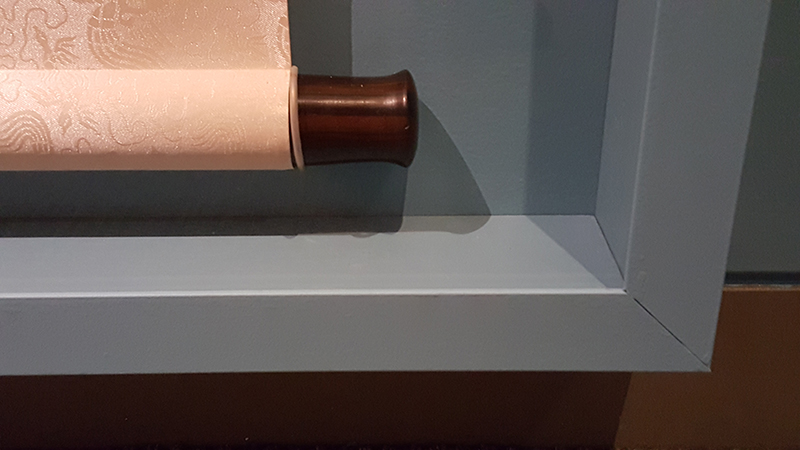
插图2。立轴下部固定法 fig.2.Detail of displaying the bottom of a hanging scroll
Install and protect hanging scroll
In general, on the top bar of the middle of any hanging scrolls, there is a string for hanging, which makes the hanging scroll seems the most easily displayable item. But in the museum, it cannot be as simple as just put a nail on the wall and hang the scroll up. First of all, we must determine its height. The height of this suspension is based on the height of the center of the entire exhibition hall, which is the most comfortable height in the audience's vision. According to the experience of American museums, this height is generally between 58 and 60 inches. If a hanging scroll is at its conventional height and its existing suspension string is used, its center height is just around this range, then, it is very simple to find such center height and drill a hole, put in a nail, and hang the artwork up. If it is an overly tall hanging scroll, it may be necessary to adjust the two ends of the scroll to achieve this uniform central height. When the upper end of the hanging scroll needs to be rolled up, some museums use a big plastic roller with one slide opening to insert top rolling bar and strings, then roll it up together with the painting till its desired height then secure the plastic roller to the wall. That should be safe. But intuitively, the plastic roller is too prominent, which compete the beauty of the hanging scroll itself. Therefore, for many years I have advocated that all display materials that are close to the exhibits should use as little or no plastics as possible. I feel that plastic material is contrary to the material and temperament of the ancient artworks in terms of perception and sense, and creates a gap in the viewing effect, and thus insist on using natural materials to show.
Many years ago, my exhibit designer invented using the original wooden stick (fig.1.Detail of displaying the top of a hanging scroll), about two to three inches in diameter (as needed), after polishing, cut to a slightly wider size than the hanging scroll's top bar, then leave the center part unpainted but painted the both end to match the color of the showcase or the exhibition halls. If the painting's top bar is sixteen-inch, than the stick could be 22 inches. Outside the 16 inches bar, each side has three inches that need to be painted with same color as for the exhibition. Then drill a hole in the center of the three inches. Wrap a layer of acid-free tissue on the unpainted 16-inch portion of the original bar, this piece of paper could be slightly shorter than 16 inches so that the edges will not be exposed. Then take it to beginning of the hanging scroll, roll it together with the painting carefully and till reaches the right height, and then secure the both side of the three inches bar with a screw, in its reserved holes. When both sides are fixed, the hanging scroll is stable, and the painting itself is naturally exposed. Because the two ends of the assisting wooden stick are painted similar to the color of the display case, or the exhibition hall, so the audience's eyes naturally draw to the painting itself, but do not see much man-kind of effort. If the lower end of the hanging scroll is too long, it can be rolled up directly to the desired place, and then the two spindle roller heads could be fixed with a circle of thick wire. One end of the wire is nailed to the wall, and the other end wrapped with a transparent soft plastic tube that hooks and holds the spindle rollers (fig.2.Detail of displaying the bottom of a hanging scroll).
整个立轴挂起后,一般还需要在画的左右两侧等距离地,各加固两三个小L形的钉,一端钉入展柜,另一端罩上透明软塑料小管,若即若离的压着立轴的边沿。一是防止立轴挂的时间久了,边沿会略微弯曲,另外,如果太贴近有机玻璃罩的话,在清洁有机玻璃罩外表时产生的静电,有可能会吸附绘画,而不利于画的保护,这样就可使画与有机玻璃罩之间保持距离。在这整个张挂立轴的过程中,所有的钉眼都要预先测量,将画挂上定位后,要以铅笔标出需要的各点(展厅陈展期间,只许用铅笔),然后取下画作放置一边,等打眼、除尘结束后,然后将画挂到位,再罩上擦拭干净的有机玻璃罩,作为最后的保护。
After the entire hanging scroll is suspended, it is generally necessary to reinforce the two or three small L-shaped nails equidistantly on the left and right side of the painting. One end is nailed into the showcase, and the other end is covered with a transparent soft plastic tube, pressing the edge of the hanging scroll. It is to prevent the hanging scroll from hanging too long to be slightly curved, in addition, it also keep the necessary distance between the painting and the Plexiglas, preventing the paintings to be sucked to touch the inside Plexiglas cover when the static electricity generated in cleaning the outer cover, which is unfavorable to the protection of the painting. During the whole process of displaying the hanging scroll, all nail holes must be measured in advance. After the painting is positioned, use pencils to mark those required points (only pencils are allowed), then remove the painting away to allow the place to be cleaned. After remove all the dust, then hang the painting back in place and cover it with a clean Plexiglas cover as the final protection.
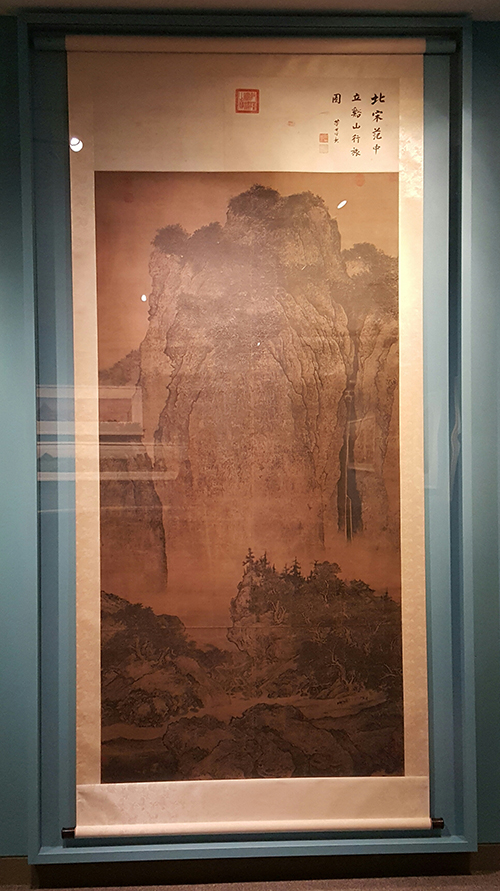
插图3。立轴陈列法 fig.3. Frame and display a hanging scroll
在这里要继续说明的是,许多博物馆有固定的展柜,所以张挂立轴时,基本上只需确定一个高度,就可在钉钩上挂画,一排一溜。我馆因为没有固定展柜,所以在陈展方式上没有如此的方便。但有利的条件是,确可因此造就每幅画的独立空间,为每幅画打造专属“画框”一般的展柜,而促使观众集中注意力观赏。对于立轴的陈展,我们一般是量体裁衣,在墙上四边筑起木框,这木框最起码要高于画面两至四英寸,依画轴的直径而定,目的是保证玻璃罩的表面与画面间有一定距离。待画张挂好后,将擦拭干净的有机玻璃板再固定于木框上,然后外加跟展墙相同颜色的木檐条,遮住木框四周的钉孔,并可将钉孔点缀成与展墙相同的颜色。如此,人工之痕迹尽量缩减到最小,而使每幅画在专属的空间,展现自己的面貌,又与整个展览浑然一体(插图3。立轴的展柜与陈列)。
It is to be noted here that many museums have permanent display cases, so when display the hanging scrolls, usually, just need to determine a height, and then could hang a row of them in the cases. The China Institute Gallery does not have these convenient permanent display cases, but gain the other favorable condition to create the independent space for each painting with an exclusive "picture frame", and thus, encourage the audience to pay attention. The way we display the hanging scrolls: we usually build four-side wooden frames on the wall. The wooden frame must be at least two to four inches in depth from the painting surface, depending on the diameter of the scroll ends, to guarantee there would be certain distance between the painting and the Plexiglas cover. After the painting is hung, covered with cleaned Plexiglas sheet and fix it on the wooden frame. Then add four strip of wooden beams with the same color as the exhibition wall to cover the nail holes around the wooden frame. In this way, the man-made traces are minimized, so that each painting is in its own space, reveals its own appearance, and integrates with the entire exhibition (fig. 3.Frame and display a hanging scroll).
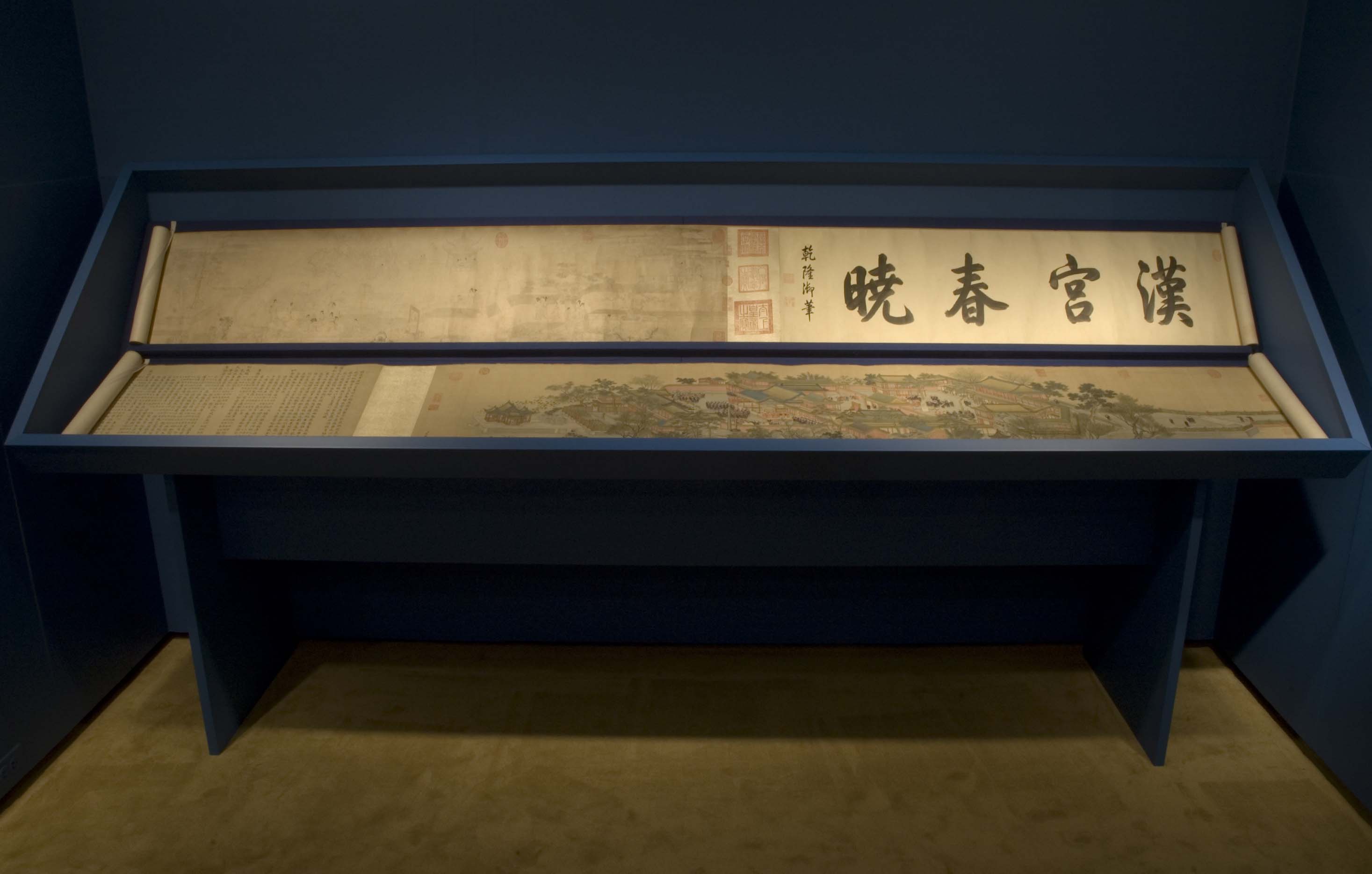
插图4。手卷展柜 fig.4. Showcases for hand scrolls
手卷的陈列与保护:陈列手卷的展柜在我们的实践中有两种,一种是独立的,可置于展厅之中;一种可依展墙而建。一般高38英寸左右,展柜平台的深度则按画面的高度而定。将展柜涂成展览所需的色彩后,需等待最起码一周以上,待漆色彻底干透,在平台上,一般可以直接平放手卷,也可再加一层裹着麻布的平板,以增加精致的效果并作保护,这一层平板有时亦可支到10到15度的斜角,让手卷略微斜倚着,特别是高度超常的手卷,又挨墙放的话,里面的画面就不太容易看到了,可以考虑采取这一有小斜坡的展示步骤,并在这一斜坡状展板的底部设一台阶,让手卷坐于其上(插图4。手卷的展柜)。
Install and protect hand scrolls
There are two types of showcases for hand scrolls in our practice. One is independent showcases that could stand alone by itself in the exhibition hall; the other can be built and attached to the exhibition wall. For either one, the height of the showcases is generally about 38 inches high, and the depth of the display platform could be determined by the height of the painting. After the display case has been painted into the same color as for the exhibition, wait at least one week until the paint is completely dry. On the platform of the case, it is generally possible to place the hand roll directly, or add a layer of flat cloth wrapped in linen to increase delicate effects and protection. This plate can sometimes be supported at an angle of 10 to 15 degrees, so that the hand scroll is slightly reclined, especially when the height of the hand scroll is too high, and is placed close to the wall, the picture is not easy to see. We can consider taking this demonstration step with a small ramp and set a wooden strip at the bottom of the ramp to allow the hand scroll to sit on (fig.4.Showcase for hand scrolls).
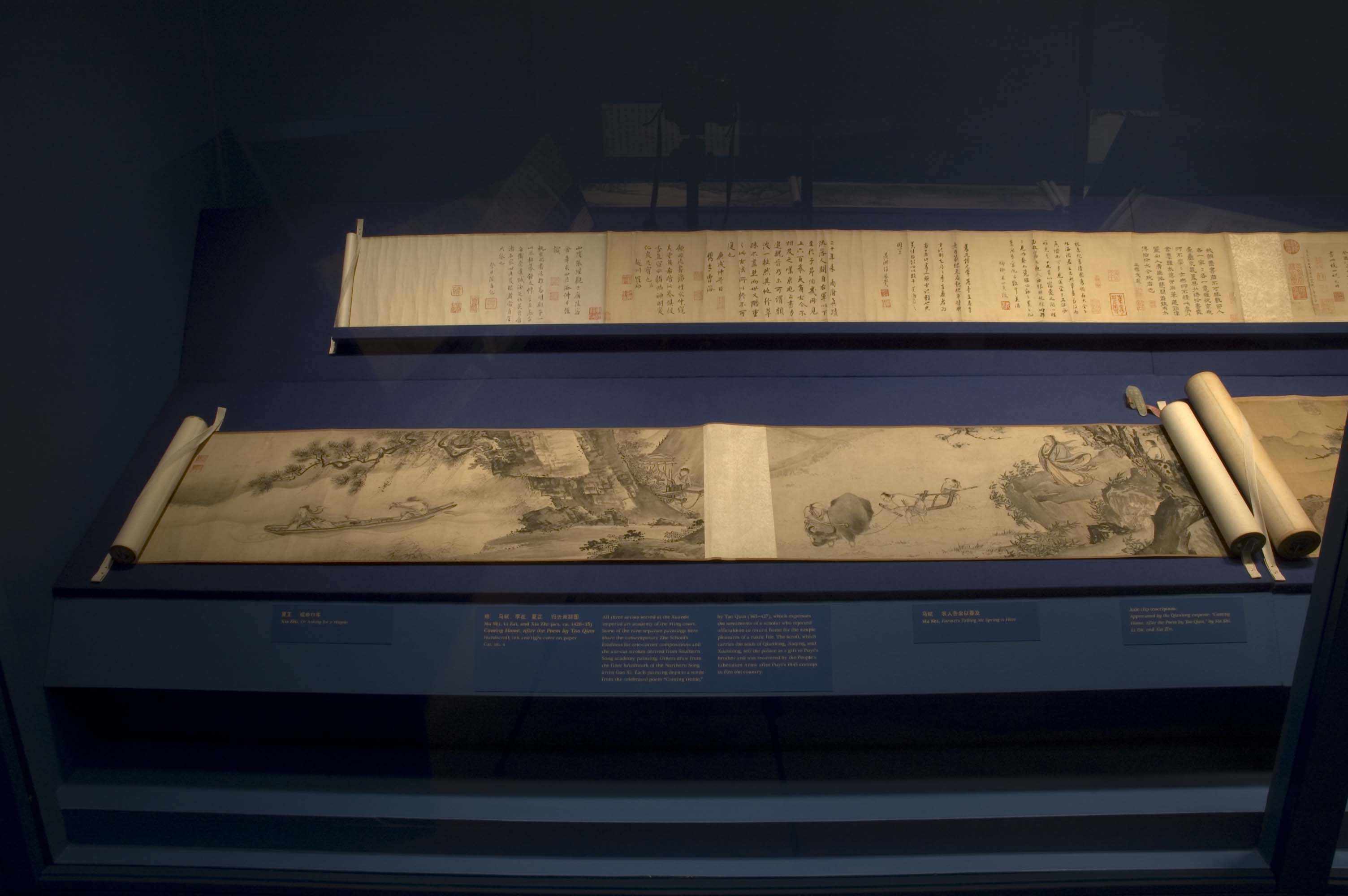
插图5。手卷陈列法 fig. 5. Installing method of hand scroll
我们固定手卷的装置方法,也是从简。在手卷一端有别子处,以小片防酸棉纸裹着卷起,一是防其摆动露出别子,更主要是使别子不直接触及画面的任何地方,哪怕是装裱的部分,卷起时也比较服帖。将宽约小于一英寸的本色麻带,剪裁成略高于手卷高度的尺寸,如果手卷高度为10英寸,这条麻带则可剪成16 英寸。两边各留三英寸,将这剪好的麻带从一开始,便夹于手卷别子处一起卷起,直卷到需要展现的画面,将卷起的这一边,把麻带捋平贴着柜面绷紧,两边各留出的三英寸处,将毛头折起,然后用胖头小钉钉住折好的麻带,在两边各钉三个钉,手卷的两边就可固定了。然后向左缓缓打开手卷,至手卷的另一边,因有实心的画轴,本色麻带无法用同样的方法卷进画轴,而需在外面斜拉着跨过手卷画轴,斜绷在画轴的两侧,将两端毛头折起后,用胖头钉固定。因为手卷尾部的轴心一般比较重,许多博物馆在这部分,多以有机玻璃的圆形支架来支撑。我们一般则以一枚或两枚两寸半或三寸的长钉,套上透明塑料小管,紧挨着轴头来加固。此外,当展示的手卷较长,为避免其中间起翘,则可等距离地以小L形钉,罩上透明塑料软管,若即若离的压着纸边。如同立轴两边的小钉做法。在此装置过程中,同理,手卷要摆放定位,打孔,除尘,清理,最后落实到位后,才将擦拭干净的展柜的有机玻璃罩罩住。一般每个展柜的罩子会用三种不同的保险螺丝钉来固定。如果螺钉显露了,有碍整个展柜的面目,还可将螺钉处涂以与展柜相似的颜色。如此,一件手卷的陈展就算最后完成了(插图5。手卷陈列法)。
Our method of fixing hand scroll is also simple. At the end of the hand scroll, there is a small pin with a string, we would first wrap that in a small piece of acid free tissue paper, and rolled up. This method first is to prevent the pin swings from the rolling, and more importantly, to prevent the pin from contacting with any part of the painting directly, and also it would be rolled more smoothly and firmly. We usually use a natural colored linin ribbon that is less than one inch wide, cut to a size slightly longer than the height of the hand scroll. If the hand scroll height is 10 inches, the ribbon can be cut to at least 16 inches. Leave three inches on each side and place this ribbon cross the hand scroll from the very beginning of rolling to the point where it needs to be shown. Then flatten and straighten the ribbon, leave three inches apart on each side, tuck the edge of the ribbon as folded and fix it with prick, a fat headed nails to the platform of the showcases, usually three nails on each side to secure this side of the handscroll. Then slowly open the hand scroll to the other side (usually to its left side). Because the other side is the solid roller, there is no space to cross the ribbon and roll in the same way. Instead, it must use a cut ribbon, the same material and a little longer length to be pulled diagonally across the scroll shaft and fold the ends of the ribbon fixed with prick nails to secure. In addition, because this solid end of the hand scroll is generally heavy, many museums are supported this end with the circular shaped plexi stand, which is so obviously seen. We generally use one or two two-and-a-half or three-inch pins, wrap it with transparent plastic tubes, closely against the hand scroll’s shaft to reinforce it. Also to prevent the surface of the long hand scrolls been warped in the duration of the display, the small L-shaped pins with plastic tubes usually equally spaced on both side of the hand scroll’s edges that slightly pressing the edges of the painting to hold it in place. During this entire procedure, the hand scroll must be positioned to make all the marks with pencils, and then remove away the painting to punch the holes, dust the display surface, cleaning, and finally put the painting back in place, and after cleaning the display case's plexi cover, to finally cover the showcase with at least three different types of safety screws. If the screws are exposed and the entire surface of the display case is obstructed, the screws may be painted in a similar color to match the display case. In this way, a hand scroll installation is finally completed (fig.5. Installing method of hand scroll).
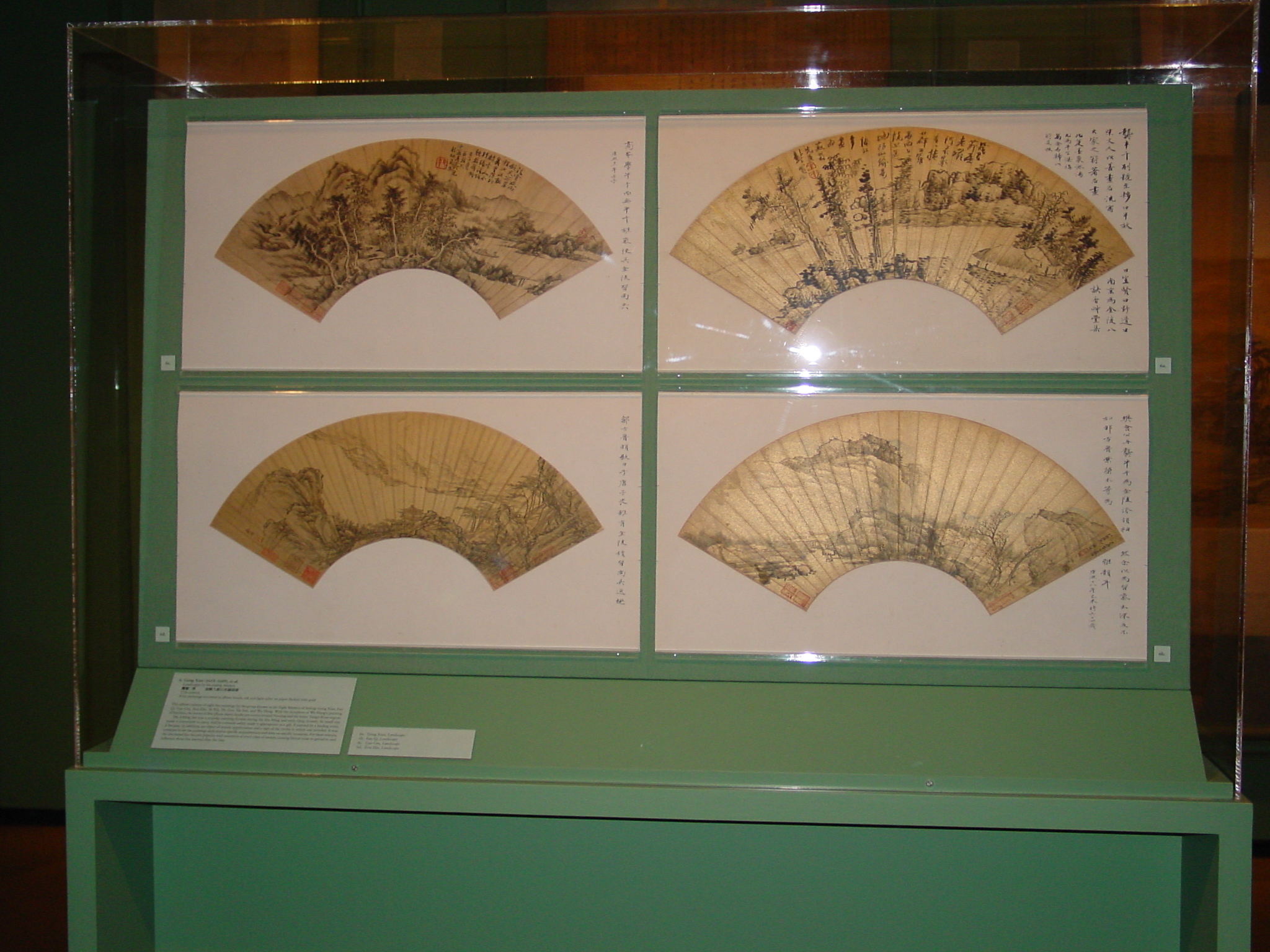
插图6。册页陈列法 fig. 6. Installing method of album
册页的陈列与保护:整本的册页,可能只能展封面,或最多展对开的两页,然后平放或搁置在一个略带斜坡角度的展架上。一般博物馆的册页,为便于展示,多已经分开。有的为对面的两开,一为画,一为题诗,如此,这两开最好都能装在同一个纸框中再陈列。如果对面的两开,一为画,一为空白,如能对折后装纸框,或不能对折,就两面皆装入同一个纸框。 装入纸框的册页,便可挨墙直立陈列。先依册页尺寸,在墙面上打造一个木框,然后,将纸框下沿承坐在一个檐条上,早期我们也用过有机玻璃檐条条来承放,那有机玻璃总显得突兀。后来还是用木檐条,做出一个L形的台阶,将这木檐条预先漆成与展柜同样的颜色,将册页坐落其上,然后在纸框的上边和左右两边用罩有透明塑料小管的L形钉若即若离的压住即可。待在木框中的一幅或几幅册页装置到位后,再盖上擦干净的有机玻璃板,钉好螺丝后,再覆盖涂有相似颜色的檐条以收尾(插图6。册页陈列法)。
Install and protect an album
The entire album may only show the front cover, or two pages up to the opposite side, and then lie or rest flat on a slightly angled display stand. However, the albums in most museums have been separated for ease of presentation. Some of them are two opposites, one for painting and one for poetry. In this case, the two openings can be first put into a paper matt and then displayed. If two opposites are open, one is a painting, and the other is a blank page, if they can be folded, then folded to put them in the paper matt. If they cannot be folded, then both sides are matted into the same paper frame. The matted album leaves will be easier to display either upright on the walls or in a slightly angles in the showcases. The ones could be displayed on the walls, first, need make a wooden frame on the wall, and then sit the matted albums on a wooden strip, though in the early stage, we also used Plexiglas as a stand, till later notice the abrupt of the plexi materials, we changed to more natural materials such as wood. Then secure the matted album leaf from its edges with a few L-shaped pins which is wrapped in clear plastic tubes. Finally, covers this showcases with a clean Plexiglas sheet with wooden beams on the four sides of the cases and fasten with security screws (fig.6.Installing method of album).
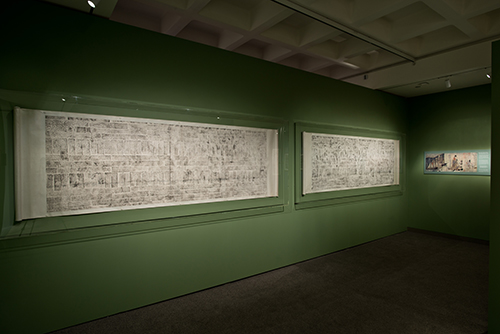
插图7。特大横幅陈列法 fig.7. Installing methof of larger banner
特大横幅的陈列和保护,2016年在做“乱世绝响:六朝艺术”一展时,南京博物院有两件西善桥的“竹林七贤”拓片,已装裱成横幅,各高82厘米,宽238厘米,横幅上端等距离地各做了三个小绢环,可以钉住挂起,但考虑到时间长了,其中间部分可能就会塌下,引起画面窝卷,而伤害作品,影响观瞻。讨论之后,我们的方案是,按照其尺寸,在墙上做了一个木框,宽有250厘米,在框内的上下两边墙板上,等距离的排列小磁铁片来压住画的上下两边,使其平整。这首先需要用铅笔定位,然后在墙板上钉钉,并在画面与墙板接触处,贴以一圈MYLA, 一种透明的硬塑料纸,置于艺术品与展柜接触的表面之间,以防展期过长,展柜颜料或因温湿度变化,有可能粘附到艺术品上。画幅摆上后,在墙板钉钉的对应处,用小磁铁吸附(预先涂成与画面相似的颜色),这样一幅长达两米多的横幅就平整而直立地陈列在墙上了。然后在展框左右两侧各有6厘米处将横幅的轴干,从上下两端以扁平的L形铁片拧上螺丝固定,中间垫以垫片以使之不直接接触绘画。待全部到位后,盖上擦拭干净的有机玻璃板钉于木框之上,最后于此木框的四周再覆盖与展柜同色的檐条遮盖(插图7。横幅陈列法)。
Install and protect large banner
In 2016, when I was doing the exhibition “Art in a time of Chaos: Masterworks from Six dynasties China”. There are two pieces of "Seven Sages of Bamboo Forest" rubbings of Xi Shanqiao from the Nanjing Museum. They have been framed into banners, each 82 centimeters high and 238 centimeters wide. The top of the banner has three small silk rings at equal distances, which can be nailed and hung. After the discussion, our plan was to make a wooden frame on the wall according to its size, with a width of 250 cm. On the upper and lower wall panels in the frame, arrange small magnets at equal distances to press the upper and lower sides of the banner to make it flat. Those magnets were previously painted to match the color of the painting. This requires positioning all those spots with a pencil marks first, then on each spot put in a nail on the wall panel and to meet the magnet, and then affixing MYLA, a transparent hard plastic paper, placed between the artwork and the surface of the display case in order to prevent any paint residue that might occur to the artworks during the long exhibition period with the changes of temperature and humidity. Then, on the left and right sides of the banner, 6 cm away from the wood frames, use a L shaped flat iron piece nailed to hold the both end of the banner, with a soft chip in between to protect the painting. After done all of these, finally, cover the entire showcase up with cleaned plexi glass sheet with nails to the wooden frame, and use the same colored wooden beams to cover the joins of the wooden frame and the plexi glass to give a unified look (fig.7.Installing method of large banner).
照明是展示艺术品的点睛之笔,也是书画陈列的最后一步。现在博物馆一般都用声控照明,依有无观众自动给光。但首先仍要调整好给每件作品合适的光线,显示其精彩,并将亮度控制在5至10 foot-candles 之间,这是美国博物馆界通用的一个标准。其它日常的保护,是温湿度的控制,一般是在50度左右(华氏),上下不超过5度(可依具体材质调整)。如需特别保护的,可在单独的展柜中置放Silica gel, 或beads,一种在独立展柜中局部调整湿度的材料。另外,展柜的护罩一般都是有机玻璃,擦拭时很容易产生静电,如艺术品太贴近,会有被吸附的可能,所以,一般要使用专门擦拭有机玻璃的清洁剂,可抑制静电,以作日常的维护 (我们常用的如Brillianize牌的清洁剂, 和Kim wipes牌的防静电的擦拭纸巾) 。
Lighting is the crowning touch to showcasing art and is the final step of installation. Nowadays museums generally use voice-activated lighting to automatically give light to audience. But first of all, it is still necessary to adjust the appropriate light for each piece of work, display its wonderfulness, and control the brightness between 5 and 10 foot-candles, which is a universal standard for American museums. Other daily protection is the control of temperature and humidity, generally around 50 degrees (US standard), up and down not more than 5 degrees (adjustable according to the specific material). If special protection is required, the Silica gel or beads also can be placed in a separate display case, a material that help to adjust the humidity locally. In addition, the protective cover of the display case is usually plexi glass, to prevent generating static electricity for sucking the artworks during wiping and cleaning, it is necessary to use the special cleaner and wiping materials that restrain electrostatic for daily maintenance (we often use “Brillianize”brand plastic cleaner and “Kim wipes” anti-stat polyshield).